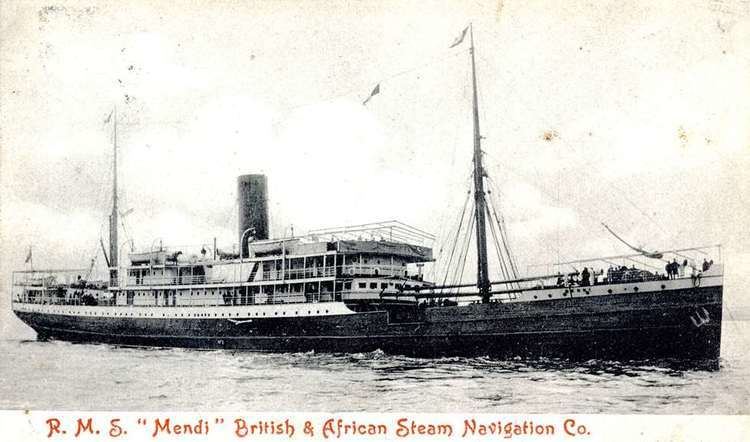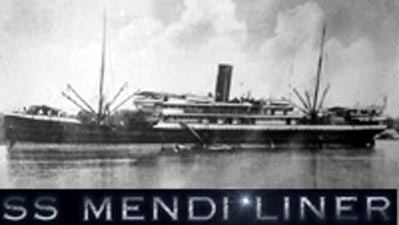Class and type passenger liner Yard number 404 Length 113 m | Name Mendi Launched 1905 | |
 | ||
Namesake Mendi people of West Africa Builder Alexander Stephen and Sons | ||
Ss mendi
SS Mendi was a British 4,230 GRT passenger steamship that was built in 1905 and, as a troopship, sank after collision with great loss of life in 1917.
Contents
- Ss mendi
- Ss mendi centenary
- Final voyage
- Loss
- Wreck site
- Monuments
- 100th anniversary commemorative events
- References

Alexander Stephen and Sons of Linthouse in Glasgow, Scotland launched her on 18 June 1905 for the British and African Steam Navigation Company, which appointed group company Elder Dempster & Co to manage her on their Liverpool-West Africa trades. In 1916 during the First World War the UK Admiralty chartered her as a troopship. On 21 February 1917 a large cargo steamship, Darro, collided with her in the English Channel south of the Isle of Wight. Mendi sank killing 646 people, most of whom were black South African troops. The sinking was a major loss of life for the South African military, and was one of the 20th century's worst maritime disasters in UK waters.

Ss mendi centenary
Final voyage

Mendi had sailed from Cape Town carrying 823 men of the 5th Battalion the South African Native Labour Corps to serve in France. She called at Lagos in Nigeria, where a naval gun was mounted on her stern. She next called at Plymouth and then headed up the English Channel toward Le Havre in northern France, escorted by the Acorn-class destroyer HMS Brisk.

Mendi's complement was a mixture characteristic of many UK merchant ships at the time. Officers, stewards, cooks, signallers and gunners were British; firemen and other crew were West Africans, most of them from Sierra Leone.

The South African Native Labour Corps men aboard her came from a range of social backgrounds, and from a number of different peoples spread over the South African provinces and neighbouring territories. (287 were from Transvaal, 139 from the Eastern Cape, 87 from Natal, 27 from Northern Cape, 26 from the Orange Free State, 26 from Basutoland, eight from Bechuanaland (Botswana), five from Western Cape, one from Rhodesia and one from South West Africa). Most had never seen the sea before this voyage, and very few could swim. The officers and NCOs were white Southern Africans.
Loss

At 5 am on 21 February 1917, in thick fog about 10 nautical miles (19 km) south of St. Catherine's Point on the Isle of Wight, the Royal Mail Steam Packet Company cargo ship Darro accidentally rammed Mendi's starboard quarter, breaching her forward hold. Darro was an 11,484 GRT ship, much larger than Mendi, sailing in ballast to Argentina to load meat. Darro survived the collision but Mendi sank, killing 616 Southern Africans (607 of them black troops) and 30 crew.
Some men were killed outright in the collision; others were trapped below decks. Many others gathered on Mendi's deck as she listed and sank. Oral history records that the men met their fate with great dignity. An interpreter, Isaac Williams Wauchope (also known as Isaac Wauchope Dyobha), who had previously served as a Minister in the Congregational Native Church of Fort Beaufort and Blinkwater, is reported to have calmed the panicked men by raising his arms aloft and crying out in a loud voice:
"Be quiet and calm, my countrymen. What is happening now is what you came to do...you are going to die, but that is what you came to do. Brothers, we are drilling the death drill. I, a Xhosa, say you are my brothers...Swazis, Pondos, Basotho...so let us die like brothers. We are the sons of Africa. Raise your war-cries, brothers, for though they made us leave our assegais in the kraal, our voices are left with our bodies."
The damaged Darro did not stay to assist, but Brisk lowered her boats, whose crews then rescued survivors.
The investigation into the accident led to a formal hearing in summer 1917, held in Caxton Hall, Westminster. It opened on 24 July, sat for five days spread over the next fortnight, and concluded on 8 August. The court found Darro's Master, Henry W Stump, guilty of "having travelled at a dangerously high speed in thick fog, and of having failed to ensure that his ship emitted the necessary fog sound signals." It suspended Stump's licence for a year.
Stump's decision not to help Mendi's survivors has been a source of controversy. Certainly Darro was vulnerable to attack by enemy submarines, both as a large merchant ship and having sustained damage that put her out of action for up to three months. But some historians have suggested that racial prejudice influenced Stump's decision, and others hold that he merely lost his nerve.
Wreck site
In 1945 Mendi's wreck was known to be 11.3 nautical miles (21 km) off Saint Catherine's Light, but it was not positively identified until 1974. The ship rests upright on the sea floor. She has started to break up, exposing her boilers.
In 2006 the Commonwealth War Graves Commission launched an education resource called "Let us die like brothers" to highlight the role played by black Southern Africans during the First World War. Although they were treated as inferior while alive, in death they are afforded the same level of commemoration as all other Commonwealth war dead.
In December 2006 English Heritage commissioned Wessex Archaeology to make an initial desk-based appraisal of the wreck. The project will identify a range of areas for potential future research and serve as the basis for a possible non-intrusive survey of the wreck itself in the near future.
Monuments
This event is commemorated by a number of monuments in South Africa, Britain, France and the Netherlands, as well as in the names of two South African Navy ships:
Monuments, ceremonies and other commemorations, such as artworks, in which the loss of men of the Mendi has been commemorated include:
